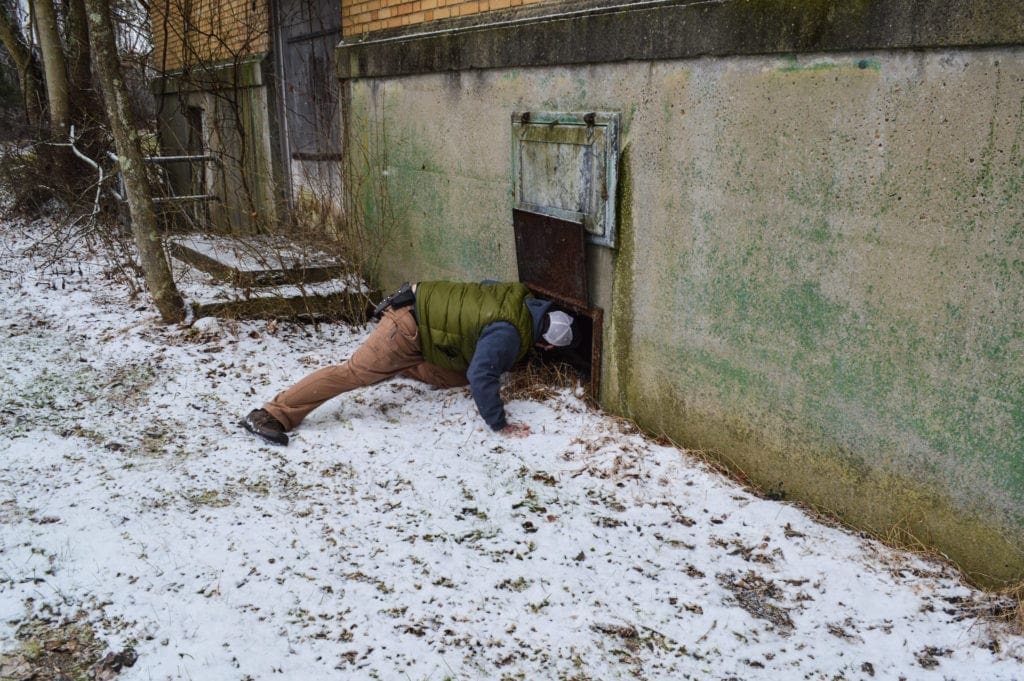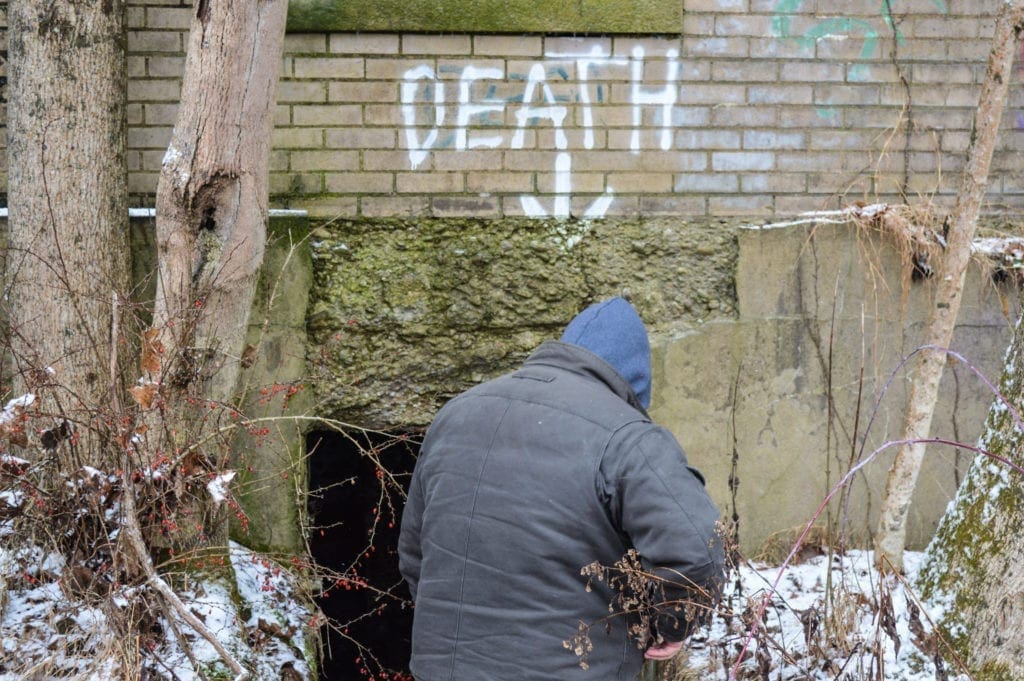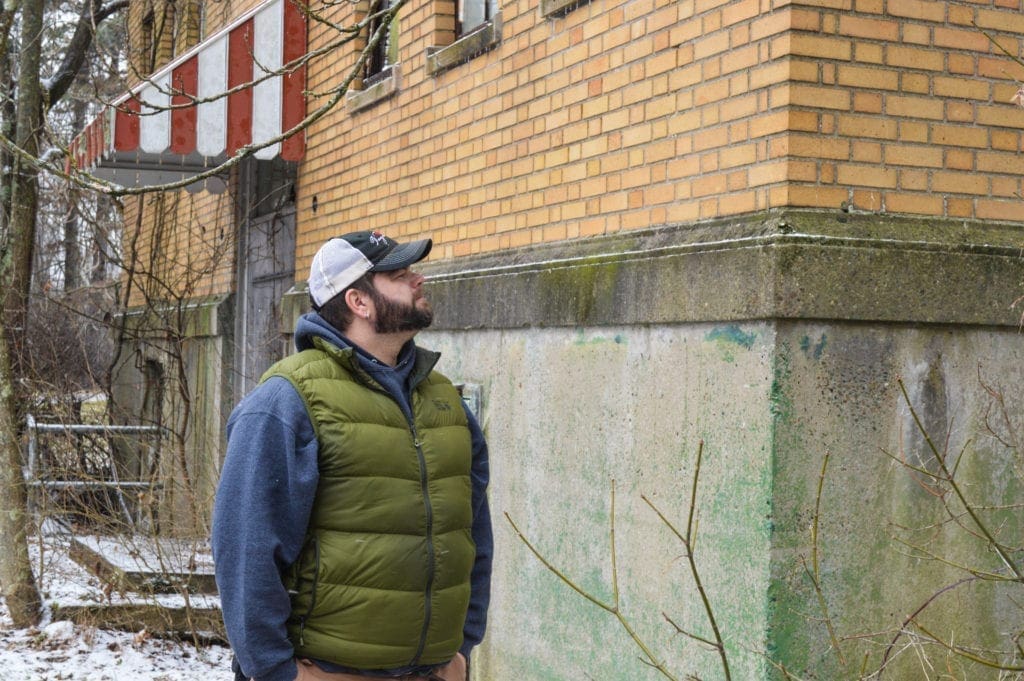(Publisher’s Note: This archived feature was published a little more than a year ago but is shared again today because of the continued curiosity of local residents about the property owned by Ohio County. The history of the area is extensive, and many visited the property during their younger years because of the rumors about ghosts of past occupants. Matt Welsch, the “Vagabond Chef” in the Upper Ohio Valley, was one of those teenagers, and he wished to return last December.)
They wanted to see some sort of ghost at Roney’s Point, or at least to be chased by the caretaking madman with the shotgun. That’s what they had heard about, and they were looking for the same thrill so many professed to experiencing.
They wanted to be scared.
One member of a group of six who trespassed back in the late 1990s admits that, even though he drove his friends there because they wanted to see anything connected to the supernatural, not one of them had an idea what that could look like. Yes, Matt Welsch now is the owner of the Vagabond Kitchen in downtown Wheeling, but he referred to himself as a, “kid somewhere around 20 years old” when he and his friends first visited this Roney’s Point hilltop. It was a trip of intrigue for the same reasons that thousands of others traveled the same trek back in the 20th Century.

Right of Passage
It was once a right-of-passage thing with the natives here in the Upper Ohio Valley because of the longstanding legends of Roney’s Point. It was said to be a place of unsettled souls as told by our elders, so, of course, despite their warnings, we went there. A trip to Roney’s Point was a suggestion from friends, and it was sometimes a dare. Fraternities from local colleges included excursions to this silent, dark, desolate destination as part of their pledging processes.
“We all came down to Wheeling one weekend, and Roney’s Point came up in one of our conversations one night, so we all piled into my old, Ford Granada and we drove out here,” said Welsch. “There were six of us, and at that time, I didn’t know anything about any of it. We had just heard that it was haunted, and we heard about a crazy man who was shooting trespassers with a shotgun.
“I don’t remember anyone in the car knowing what we were doing. I think, maybe, there was one of the six of us who had been out here before, but it wasn’t me, and he didn’t remember much,” he said. “So, we just went out looking for stuff, and we saw the remains of the mansion, and that’s where we stopped. We pulled into the driveway, got out, and just started crawling around the property and just explored the whole thing, and we didn’t think twice about what could have collapsed on us. We were too intrigued.”

Not a Hospital
But it wasn’t what they thought it would be, a mistake made by many who really were searching for the former hospital located less than a half-mile from the remnants of the mansion that was constructed by Wheeling brewer Henry Schmulbach in 1911-12. Welsch and his friends stopped too soon.
“We thought the mansion was the asylum we heard so much about, and that’s really why we didn’t venture any further up the road. We thought we reached what we were looking for because we didn’t know any better,” he explained. “After that trip, though, I went to the Ohio County Public Library and looked up a bunch of stuff on the property, and that’s when I realized what we had found, and what we didn’t. That’s when I figured out the asylum was out past the mansion.
“That’s why I wanted to come out here again,” Welsch added. “This was the first time I saw where the hospital is, and what kind of shape it’s in now. There’s a part of me that wants to walk through it because of the history.”
The Roney’s Point property belongs to Ohio County and is now where gas and oil extraction has been taking place for nearly a decade. The Schmulbach property became the county’s Poor Farm once Schmulbach died in 1915, and his widow sold more than 500 acres to the county.
The Actual Hospital… and Asylum
In 1936, in reaction to the countrywide tuberculosis outbreak, a hospital was constructed and opened on land beyond the Schmulbach Mansion on Roney’s Point. The facility was considered “in the middle of nowhere,” and that was necessary to contain the highly contagious respiratory disease. During those days, such a diagnosis was a death sentence.
Once a TB vaccine was developed and was readily available in the 1940s, the 40-bed facility transitioned into a mental health asylum in the early 1950s. So many afflictions well-known today were referred to as simply “crazy” a half-century ago, including dementia, schizophrenia, bi-polar, depression, and even drug and alcohol addiction, and the county’s “lunatics” were locked away, too.
“We were ghost hunting to a certain degree, but really, we didn’t know what to look for because we knew nothing about the Roney’s Point grounds or the history. Seriously, it was just a really cool falling-apart-building that we had heard about, and we knew other people went out there, so that’s what we did,” Welsch said. “The allure with urban decay was a big reason why we came here.
“And it was an urban legend back then, too, and I think it still is today to the people that grew up around there during those years,” he said. “I have no idea how the generations below me feel about this type of thing, but it was definitely something we did because of the cool stuff we heard about the place. Plus, there were places where our parents would tell us not to go, so, of course, we went to those places, too.”

Close Encounter
One member of Welsch’s group got spooked while scaling the mansion’s steps to the top floor and suddenly insisted on leaving the county property. Welsch was leading his group up those steps, and at the top he and a female member of the group discovered a spray painting she deemed evil.
“No one else was up there when we first got there, and we went around the back of the mansion before going into the basement, and from there we explored all of the floors of the building,” Welsch recalled. “But when we got up to the top floor, a female in our group just wanted to get out there because she was super freaked out, so that’s when we scrambled out of there like kids do. When we got to the car, though, we saw a set of headlights coming up the drive.
“We were so dumb. We all got into the car, and we all ducked down because I couldn’t find my car keys, but those people stopped where we were, and they were people who shouldn’t have been up there either,” he said. “They had a baseball bat, and they tried to scare us, and one of them hit my car window with the bat. That switched us from being scared to being ticked, so after I found my keys in my damn pocket, we went hunting for them, but could never find them.”

And This Time?
It was 28 degrees, and flurries were flying in a wind-chill that dipped the mercury into the teens. There were tree-trimming crews in the area buzzing away branches that threatened power lines, but otherwise, Roney’s Point rests more as a memory for former employees and their children, nearby neighbors, and for the young folks who dared to visit this alleged dead land.
“It’s hard to believe that it has been nearly 20 years since I’ve been up here to explore anything, but the decay has definitely progressed more than I expected,” Welsch said. “I can remember being careful inside the mansion, but today the floors were super soft, and I walked very carefully … much more carefully than I remember from that first time.
“Today, I didn’t walk around very much because, well, I really didn’t need to fall through any floors,” he said seriously. “It is absolutely a dangerous place that I would warn anyone about. I won’t encourage anyone to come up to go inside, or to try to get into the hospital building based on what I saw. If you come up here to see where these buildings stand, fine, but stay in the car. It’s dangerous out here.”
But Welsch did enjoy his return trip to Roney’s Point because it fed his appetite for history and knowledge, yes, but it also placed him in a position to recall his days as a woods-venturing youth while growing up in the Limestone area of Marshall County. There’s no hum of highways or echoes of conversation on this hilltop, but there is the inevitable.
“What was interesting to see today is that nature is reclaiming it,” Welsch said. “It’s December, but there’s still a lot of plant life growing all over the place, and there are trees growing out of the middle of the mansion in what appears to be a great room. Now, that’s not true at the asylum, but those grounds are kept up, but the area of the mansion is not in any way. I imagine what it looks like in the middle of summer.
“So many of the buildings we saw standing back then are collapsed now, and I saw nothing of the greenhouse like I did back then. I don’t know, maybe I didn’t walk out far enough this time,” he recalled. “It was a chilly trip because it was only 28 degrees, but that added something to it for me. There is a beauty I see when everything goes to sleep even though I know some people see it as everything dying. Not me. I see it as more of a peaceful situation. To me, it’s a dormant beauty.”










